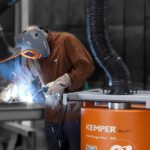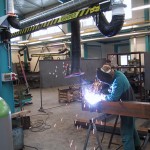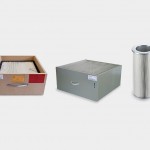Collect and separate: how to achieve effective occupational safety
Extraction and filter technology is fundamental to effective occupational safety. But the behavior of the welder is also significant. Thus collection efficiency is not the same as filtration efficiency.
What good does it do occupational safety to use the best filter for extraction and filtration if the welding fumes are insufficiently collected in the first place? Metalworking plants and the welders themselves must never lose sight of this question. Guaranteeing effective occupational safety in the workshop requires not just having the best filters in the system. Rather, in addition it’s essential to be highly attuned to the correct use of extraction and filter technology.
Collection efficiency is not filtration efficiency
It’s not a coincidence that occupational safety distinguishes between collection efficiency and filtration efficiency. While the filtration efficiency says something about the quality of the filter, the extraction technology affects the collection efficiency, but even more so the behavior of the welder. This is even more significant. If occupational safety equipment is not professionally utilized, polluted air can escape into the work area unfiltered. The fact that this happens is partly due to low awareness of occupational safety among the welders themselves. This in turn may be due to the fact that many extraction systems for welding are simply too impractical and hinder the welders. But in the best case scenario, extraction should make a welder’s work easier.
Exhaust hood can influence collection efficiency
Metalworkers can achieve high collection efficiency through the optimal configuration of an exhaust hood, for example. This device is free-moving and self-supporting, and an integrated light enables optimum viewing of the workpiece, so that welders alone can check their work.
Filter technology comes into play as a second step. Example: in a best case scenario, 100 percent of all hazardous substances would be extracted from the point of origin. But here’s where the filter comes into play, and filtration efficiency plays a role. W3 filters separate more than 99 percent of respirable particles out of polluted air. These filters, however, are not required to be used if certain materials such as iron oxide or copper oxide are released. Today W3 filters already offer a high degree of filtration efficiency for ultrafine dust particles.
“Efficient welding fume extraction alone is not sufficient”
Effective occupational safety during welding entails both a high collection efficiency and a high filtration efficiency. To achieve this, filter technology and the configuration of the exhaust hood are significant, but above all, the behavior of the welder. In the industry newspaper Produktion, Dr. Vilia Elean Spiegel-Ciobanu from Berufsgenossenschaft Holz und Metall (Wood and Metal Workers Insurance) explained: “An efficient welding fume extraction alone is not sufficient. Rather, we must focus on collecting as much welding fumes as possible.”





